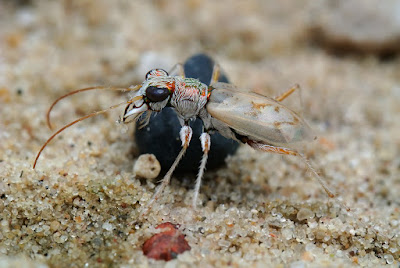"The dream of my life is to lie down by a slow river and stare at the light in the trees — to learn something by being nothing — a little while but the rich lens of attention."
— Mary Oliver
Nice, eh? It's rich with tiger beetles right now. This particular spot at Sauk Prairie Recreational Area reminds me of a place we called "The Sand Pit" when I was a little kid growing up on the northeast side of Madison. Great fun was had there playing with GI-Joe and Planet of the Apes action figures, building forts, riding our bikes on the nearby trails, etc. — Gen X type stuff. It was also one of the first places I discovered tiger beetles. I can't recall what species they were, though it was likely Big Sand and Punctured given the habitat.
Alas, the sand pit is long gone — from Google Earth it appears to be all marsh and sedge habitat today, which is probably better for birds and other critters. Perhaps there's an element of nostalgia and reminiscence in visiting this location at Sauk Rec that harkens back to childhood. Whenever I'm here, I'm totally absorbed in what I'm doing — searching for flora and fauna to appreciate and photograph. There's something about it that makes it feel timeless.
Deptford Pink Dianthus armeria is a species of flowering plant in the family Caryophyllaceae. It is native to Europe but has naturalized in many parts of North America. It's probably my favorite non-native wildflower and it's presence at Sauk appears to be closely timed with the emergence of Ghost Tiger Beetles.
They weren't yet blooming during my previous visit, but they were this past Sunday — and the Ghosts were out and active. It's just something I've noticed in visiting this spot season after season for the past several years. Anyway, the Ghosties ...
No matter how many times I encounter these beetles, I'm initially astonished just how small they are compared to other tiger beetles — some appear to be a mere 7 to 8 mm in length, mandibles to pygidium (abdominal terminus).
Rapidly moving clouds rendered a variety of exposure challenges. When the sun is shining, you can see the beetle's shadow — the color is more saturated and contrast higher. When clouds block the sun, I have to change the exposure, but I don't always get it right.
Shadow above, but a little under-exposed; no shadow below and a bit over-exposed.
It's always a good idea to get a few shots of the elytra for comparison of individuals by maculation pattern. As a kid, I was a pinner — but I have no desire to collect and case them today. And yet it was partly due to collecting them that kindled my interest in insects, admiring them in the comfort of my home. It has lasted a lifetime, as the same kind of appreciation exists today with digital imagery. Macro photography allows for the same admiration and study of these fascinating creatures without the need to collect and pin them. It offers a way to share and document biodiversity while preserving the specimens in their natural habitats.
Noting maculation patterns gives me an idea how many individuals are present.
Based on location, proximity, and studying the photos, I'd estimate there were around a dozen Ghosts present during the outing.
Another example of the difference in sunlit versus overcast ...
Again, almost no shadow ...
The Ghost Tiger Beetle — so cool and so much fun!
During the same outing, I found my first Punctured Tiger Beetles of the summer season. This one appears to be finishing a meal — looks like ant parts.
Same individual, different substrate ...
Here's a Robber Fly Efferia albibarbis sucking the life out of prey ...
A nasty death, but can the fly actually feel anything? Does it know it's doomed to non-existence?
Probably not!
This is a striking display of insect on insect predation — I'm grateful robber flies are so small. It's fascinating to consider that these interactions are driven by innate behaviors programmed into their nervous systems, much like a computer follows a set of instructions. While insects can respond to stimuli, their responses are likely automatic and lack the conscious experience of pain or awareness of dying. Having said that, scientists have long known that insects do display nociception (ability to detect potential harm). If an insect experiences damaging stimuli, it is not necessarily an indicator of "ouch-like" pain as other non-human animals most certainly have.
This is a favorite hymenopteran (bees, wasps, etc.) of mine — an American Sand "digger" Wasp Bembix americana hard at work ...
They're pretty challenging to photograph, perhaps even more skittish than tiger beetles. One slight move and off they fly!
Doing what they do best ...
I also found my first treehopper of the season — a Wide-footed Treehopper Enchenopa latipes.
No matter where I've gone to explore this June, the moment I step out of my vehicle I hear the calls of Dickcissels — it's a banner summer to observe them. Now beyond the solstice, already to the far north, natural and celestial cues are beginning to render a stir in the Realm of the Aves — fall migration soon begins. For now, there's a lot more insecting to do!
All images © 2024 Mike McDowell

























